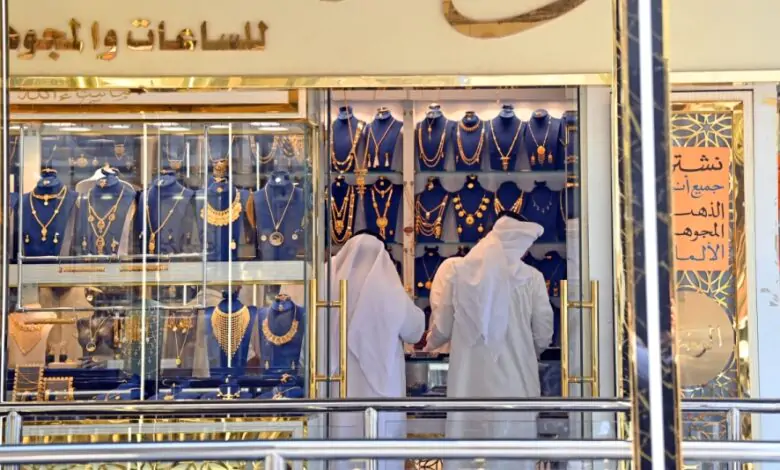Kuwait’s once-thriving Gold Demand market is witnessing a noticeable downturn as consumers pull back on purchases amid skyrocketing prices and mounting fears over the global economic outlook. The shimmering appeal of the yellow metal appears to be fading for many Kuwaitis, who now find themselves at a crossroads between tradition, investment value, and financial caution.
Rising Prices Cool Shoppers’ Enthusiasm
The primary force behind this drop in demand is the sharp rise in gold prices. In the first quarter of 2025 alone, global gold prices surged by 25%, pushing local rates to new highs. In Kuwait, the cost of 24-karat gold jumped by KWD 6.5 per gram since December, with other purities such as 22-karat and 21-karat gold also seeing significant increases. While gold has long been seen as a hedge against inflation and financial instability, the dramatic price hikes have placed it out of reach for many middle-income consumers.

Even with gold being a cultural staple in the Gulf region—frequently purchased for weddings, festive occasions, and long-term savings—the current economic conditions have dampened enthusiasm. Buyers are becoming more selective, often delaying purchases or opting for smaller pieces as they await potential price corrections.
A Sharp Fall in Jewelry and Investment Demand
Jewelry consumption, traditionally the largest segment of gold demand in Kuwait, has suffered the most. According to recent figures, the volume of gold jewelry purchased in the country dropped by a striking 20% in the first quarter of 2025. From 3.1 tons last year, purchases slid to just 2.4 tons in the same period this year. Retailers across Kuwait have confirmed a visible decline in foot traffic and customer inquiries, particularly for heavier, high-karat gold pieces.
Gold bars and coins—usually favored by investors—also saw a 5% drop in demand compared to Q1 2024. The dip, although less severe than that of jewelry, is noteworthy given that investment demand had shown resilience in previous years. Many analysts believe this reflects growing consumer anxiety about market timing, with buyers hesitant to invest at a perceived price peak.
Long-Term Trends Reveal Shifting Preferences
Zooming out, the gold market in Kuwait has seen considerable fluctuations over the past five years. Total gold consumption between 2020 and 2024 stood at 86.4 tons. This includes 64.5 tons of jewelry and 21.9 tons of investment-grade bars and coins. Jewelry consumption peaked in 2022 at 14.7 tons but has since declined to 12.3 tons in 2024. On the other hand, investment in bars and coins has grown steadily—from 2.7 tons in 2020 to 6.1 tons in 2024—indicating a shift in consumer mindset from adornment to asset preservation.
This trend aligns with broader regional patterns. Throughout the Arab world, consumers have become more investment-savvy, particularly in the face of inflation, currency instability, and geopolitical uncertainty. Kuwait, ranked as the fourth-largest gold market in the Arab world after Saudi Arabia, the UAE, and Egypt, remains a significant player but is now navigating a more cautious and complex gold landscape.
Economic Anxiety Weighs on Sentiment
Underpinning this shift is a growing sense of economic unease. Global financial markets remain volatile, inflation is stubbornly high, and geopolitical tensions continue to unsettle investors. Locally, concerns over job security, real estate stagnation, and slow economic reforms are making Kuwaitis more conservative with their spending. This sense of caution is not unique to Kuwait but is part of a broader regional trend where consumers are re-evaluating non-essential purchases.
Gold, once seen as a safe haven, now also carries the burden of being a volatile asset. While many still believe in its long-term value, the short-term price fluctuations have added an element of risk, especially for small-scale investors or those buying gold for traditional occasions rather than financial returns.
Market Adapts to New Realities
Gold retailers across Kuwait are adjusting to these market realities by diversifying their offerings. Many are introducing lighter, more affordable designs to attract price-sensitive customers. Some have also started offering installment plans and buy-back guarantees to make gold more accessible. Additionally, online platforms are gaining traction, allowing customers to monitor prices and make informed decisions with greater flexibility.
Financial advisors are also reporting increased interest in alternative investment vehicles such as savings bonds, mutual funds, and real estate. For younger Kuwaitis, especially, the glitter of gold may no longer hold the same emotional or financial appeal as it did for previous generations.
Looking Ahead
As the market stands, the outlook for gold in Kuwait remains uncertain. Much will depend on global price movements, inflation trends, and local consumer confidence. If gold prices stabilize or decline slightly, demand could rebound in the second half of the year, particularly during the wedding season and religious holidays, which typically see a spike in jewelry purchases.
However, the underlying shift in consumer behavior suggests a more cautious and value-driven approach to gold buying moving forward. Retailers, investors, and policymakers alike will need to adapt to this evolving landscape—one where gold remains valuable, but no longer untouchably desirable at any cost.
In the end, gold in Kuwait may not have lost its shine entirely, but it’s certainly being viewed through a more practical lens. What was once a symbol of prosperity and tradition is now a commodity being reevaluated amid rising costs and financial pressures. The glint of gold still sparkles, but the decisions behind each purchase are now more calculated than ever.


